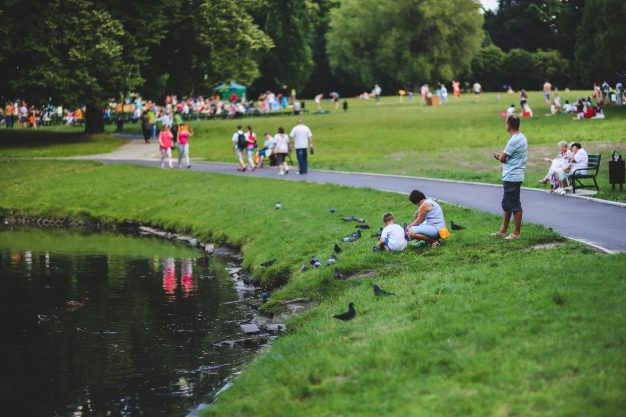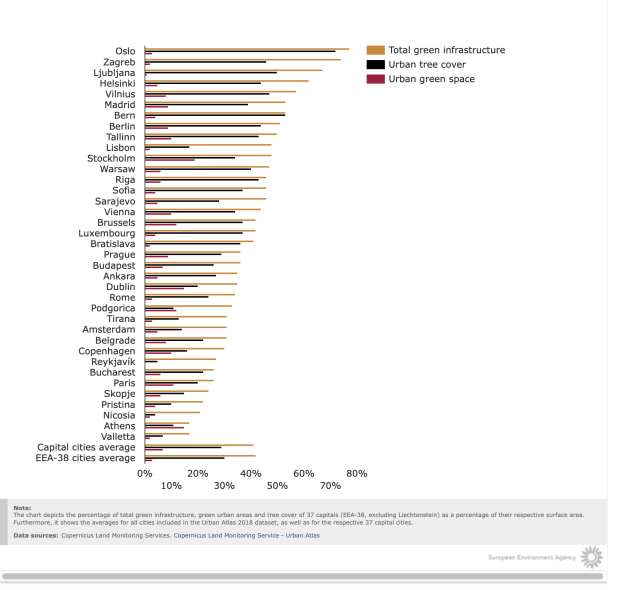
How green are European cities? Green space key to well-being of children, but access varies
High-quality green and blue spaces in cities, such as parks and riverbanks, are crucial for children’s health and well-being but access is not equal, according to a new briefing from the European Environment Agency (EEA).
The opportunities to access these spaces across the continent are hugely varied, says
The study found that cities in the north and west of Europe tend to have more green space than cities in southern and eastern Europe. The assessment looks at socio-economic and demographic inequalities in access to green and blue spaces in European cities. It also includes examples of green spaces that were designed to meet the needs of vulnerable and disadvantaged social groups.
Value of green spaces in cities
The potential for green spaces to boost our health and well-being is increasingly recognised, both in science and policy. Accessible green areas are especially important for children, the elderly and people with lower incomes, many of whom have limited opportunities for contact with nature, adds the EEA, an agency of the European Union which provides sound, independent information on the environment.
People use their local green spaces for physical exercise and social interactions, for relaxation and mental restoration. Benefits range from reduced risks of obesity in children, to better cardiovascular health and lower rates of depression in adults. Parks, trees and other green areas improve air quality, reduce noise, moderate temperatures during hot periods, and boost biodiversity in city landscapes.
How green are European cities?
Green infrastructure, which includes green and blue spaces like allotments, private gardens, parks, street trees, water and wetlands, made up on average 42 per cent of the city area in 38 EEA member countries, according to the latest data available. The city with the highest proportion of total green space (96 per cent) is Cáceres in Spain, where the city’s administrative area incorporates natural and semi-natural areas around the city core. The city with the lowest total green space at just seven per cent is Trnava in Slovakia.
With regard specifically to children and young people, the report says greener environments are linked to better physical and mental health, including improvements in memory, attentiveness and learning ability, and a reduction in stress. Parks and playgrounds encourage participation in social activities, thus contributing to social well-being and social cohesion.
Nature-based education and play can help children develop their motor skills, as illustrated by an example of green schoolyards in Flanders in Belgium. In contrast, studies suggest that young people and children with relatively low exposure to green space are more likely to have poorer eyesight, suffer from obesity and be exposed to oxidative stress.
In general, publicly accessible green areas form a relatively low share of total green space, estimated at only three per cent of the total city area on average. Yet, this varies between cities, with cities such as Geneva (Switzerland), The Hague (Netherlands) and Pamplona/Iruña (Spain), seeing accessible green space account for more than 15 per cent of the city area.
The latest data from the EEA’s urban tree cover viewer shows that average urban tree cover for cities in 38 EEA member and cooperating countries stood at 30 per cent, with cities in Finland and Norway having the highest proportion of tree cover, while cities in Cyprus, Iceland and Malta had the lowest.
Inequalities in terms of access are present – policy and action emerge
Across Europe, green space is less available in lower income urban neighbourhoods than in higher income ones, with differences often driven by the housing market, where properties in greener areas are more expensive. While the World Health Organization recommends that all people reside within 300 metres of green space, less than half of Europe’s urban population do. National and local guidelines vary across Europe and guidance on how to make access equal across social groups is rare.
Case studies from across Europe show how targeted action to reduce inequalities in access to high-quality green spaces can maximise the health and well-being benefits of nature in cities. Involving local communities in the design and management of green space helps in considering their specific needs and has been found to foster a sense of ownership and promote use.

The source for this article is the European Environment Agency, which also allows republishing under Creative Commons Licensing guidelines. Click here to access the original article, including an interactive version of this table.




